Proper shutdown of the laptop
Improperly shutting down a laptop can damage operating system files, including significantly reducing its service life. hard drive. Laptops are no less demanding to shut down correctly than regular desktop computers.
There are several ways to properly turn off laptops; their choice primarily depends on for what purpose and for what period of time you are going to turn off the laptop.
1. Traditional shutdown.
Start/Shutdown. In Windows 7, 8, the laptop will turn off without further questions. At the same time, everything open applications will be completed automatically and the data will be saved. The shutdown itself will take about a minute, the restart will take several minutes, which will be needed to load the operating system and scan the executable files with the antivirus.
On Windows XP operating system will clarify what action needs to be performed, and only after secondary confirmation will it turn off the laptop.
In principle, you can always turn off your computer in the traditional way. But in cases where you are going to connect to a laptop external device(for example, a second monitor) or you plan not to use the device long time, this method is the only correct one.
2. Power off using the Power indicator button, which is usually located under the monitor.
This button, if configured to shut down, allows you to correctly turn off the laptop with one short press while preserving all the settings of the previous session.
3. Closing the laptop lid.
Under certain settings, closing the lid puts the PC into sleep mode. In this case, the programs may not be terminated. After turning on (short press on the Power Indicator button), all unfinished programs will continue to work, with the possible exception of the network connection.
When powered from the mains, the laptop can be in sleep mode for a long time, and if you use it constantly, then sleep mode will allow you not to turn off the computer at all.
If the battery runs out during sleep mode, the laptop will shut down all applications and turn off automatically.
4. Shutdown using the key combination Ctrl+Alt+Del.
The method is indispensable in cases where the laptop does not respond to user commands, i.e. “freezes”. Pressing this combination once brings up the Task Manager, and pressing it again leads to a reboot.
5. Forced de-energization of the laptop.
This method cannot be considered correct; you have to resort to it when the laptop completely freezes, the keyboard is blocked and does not respond to any user commands. You can turn off the power to the laptop by long pressing the Power indicator button. In the worst case scenario, you will have to unplug the laptop and remove the battery for a few seconds.
In this first article, we will look at the answer to the question that you will encounter first: how to properly turn off your laptop.
Let's say you turned on your laptop. There is no room for imagination to run wild here and, apparently, you made this the only possible the right way- through a button on the body. This button is located separately from the keyboard, and you can easily find it. The laptop will make noise when it turns on the cooler fan, make a characteristic melodic sound and greet you.
Shutting down a laptop on Windows 7.
Now let's talk about shutdown. There are several modes that can be used when working with a laptop. And the lifespan of the battery of your “toy” depends to some extent on the wise choice between them.
At the bottom of the screen you will see a ribbon with icons lined up in a row - . We are now interested in this icon.
Start Menu button
And this is how it looks in version 10 of the Windows operating system:
This is an icon or, as it is also called, the Start Menu. You can open the Start Menu either through the keyboard or with the mouse. Usually at the bottom of the keyboard, next to long key space bar, there is a key with the Windows operating system icon.
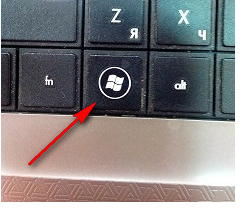
Feel free to click. Or we point the arrow at the above icon and click once on the left mouse button.
On the right, at the bottom of the window that opens, we see a button Shutdown
If you do not plan to work in the next few hours, you need to click on this button once with the left mouse button. All. The computer is completely turned off.
Various laptop shutdown modes.
To get acquainted with other states of the computer, left-click once not on the button, but on the arrow icon located next to it, and see context menu. It lists the modes that are available for our device. Their names may differ depending on the installed operating system and computer model, but these differences are minor.
So we have Sleep mode (Dream ), Hibernation , Sign Out .
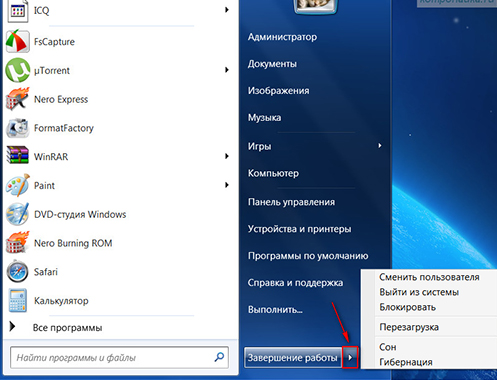
View available modes
Sign Out.
Sign Out is necessary when the computer has several users, each of whom logs in with their own password.
Hibernation.
Hibernation is the least energy consuming mode provided in the operating room Windows system. In hibernation mode, the computer first falls asleep, and after some time it turns off completely. However, at the same time, it saves in memory all the pages and tabs that you left open. And the next time you turn it on, they will be available to you again without any additional “body movements”.
Dream.
Dream - a very convenient opportunity to save energy and quickly get back to work. If during the day you go to the computer several times, and the breaks between approaches are approximately 0.5 - 1.5 hours, this mode is ideal for you. You don't have to go to the Start Menu to use it. Just lower the laptop lid ( hold not by the edges, but by the middle), we wish you sweet dreams and let's go have tea. “The beast will fall asleep,” calm down (turn off the cooler) and will no longer bother you.
Options for exiting sleep and hibernation modes may vary slightly, but one of the following will definitely work for you: move the mouse, click the mouse, press any key. Although it is often enough to simply open the laptop lid. If the laptop does not wake up and still shows no signs of life, just press the power button.
During sleep, the laptop can be either connected to the network or disconnected from it. Electricity consumption in this mode insignificant. If the battery level in sleep mode becomes critical, the operating system itself will put your device into hibernation mode.
Turning off a laptop on Windows 10.
If you have a Windows 10 operating system, you will find new button Start menu and simplified laptop shutdown system.
To turn off a laptop with Windows 10 installed, left-click on the Start Menu icon on the Taskbar or click on the keyboard Windows button(described above).
In the menu that appears, select the item Shutdown. Click on it with the left mouse button.
A small window with three items will appear. For complete shutdown laptop you need to select the item of the same name Shutdown.
Waiting for your comments!
Windows 8 is a new operating system, the interface is significantly different from previous versions. One of these differences is the absence of a Windows button. In version 8.1 it is available, but when you click it you just get to the tiled menu. Because of this, many users have a question: how to turn off a laptop on Windows 8? After all, as a rule, the function of turning off the PC is hidden in the start menu.
In this article we will look at everything possible methods turning off the laptop, including tools for setting a timer.
How to turn off a laptop with eight
In fact, there are many ways to turn off a laptop. Most of them worked in previous versions. Among them the following can be noted:
- Key combination Alt+F4.
- Simultaneously pressing Ctrl+Alt+Del.
- Through computer settings.
- By the same pressing the Windows button on the keyboard.
- Assigning shutdown to the power button.
- Using the Run dialog.
- Using the command line.
In addition, there are other methods, for example. This is useful if you do not need to turn off your computer during this moment, but you need to schedule a shutdown, for example, in an hour, but at the same time you will not be near the PC at that time. So, let's look at all these ways to turn off a Windows 8 laptop.
Turn off your PC using a key combination
First of all, it should be noted that key combinations were provided to simplify computer control. Therefore, this disconnection is the simplest and fastest. The first combination is simultaneous pressing Alt and F4. Pressing these buttons at the same time closes applications. But if you click them on the desktop, a menu will appear in which one of the options is to turn off the PC.
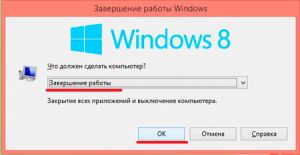
It is worth noting that before doing this, you need to close everything running programs and save important data. And only after that proceed to shutdown. The second key combination is Ctrl+Alt+Del. Pressing these buttons at the same time opens a separate menu in which you can manage your account ( , launch the task manager, and so on). But among other things, in the same menu you can turn off the computer.
So, above we looked at the simplest method of turning off a laptop. But there are other options.
How to turn off a laptop through system parameters
There are two ways to open the settings:
- Move the cursor to the right top corner, and click on the “Options” button.
- Using the Windows key combination + I.

In any case, you will be taken to a menu from which you can turn off the PC or restart it. As you can see, everything is extremely simple. Another way to turn it off is to click on Windows key. In this case, you find yourself in the tiled menu of the operating system. Here in the top right corner you will see an icon account, and a little to the right is the power button. Click on it and select the appropriate item.

Turning off the PC using a key combination: Video
How to assign laptop shutdown to the power key
Every computer, including laptops, has a power button. When pressed, the device turns on. But in the case of laptops, when they are running, pressing this button does not turn off. The device enters Hibernation mode. This is similar to sleep mode, only in in this case The PC saves all data in a file located on the hard drive. In this case, the RAM is completely freed.
This is similar to sleep mode, only in this case the PC saves all data in a file located on the hard drive. In this case, the RAM is completely freed.
The advantage of hibernation mode is that the computer requires much less energy to save settings than sleep mode. This suggests that, in principle, it is not necessary to turn off the laptop; it is enough to press the power button and send the device into hibernation mode. The computer can remain in this state for a very long time, since practically no energy is consumed.
Turning off the computer on Windows 8 using the power key: Video
But, if you are still determined to turn off the laptop every time, then you can assign a shutdown function to the power key. To do this, in the lower right corner (the so-called tray) we find the battery icon. When you click on it, a menu opens from which you can select a power plan.

In this menu you need to select “ Extra options power supply." Next, open “Actions of the power buttons.” In the menu that appears, you can select the actions that will occur when you press the power button, as well as when you close the laptop lid and press the sleep key.


This means that you can configure your device as you see fit. For example, when you close the lid, the laptop will turn off or go into sleep or hibernation.
How to shut down your computer using the command line and the Run menu
So, another way to turn off a laptop in Windows 8 is to write and execute a special command. First, let's open the command line. This is done by simultaneously pressing two keys – Windows + X. In the menu that appears, select “Command Prompt (Administrator).” Now you need to write the command - shutdown /s /t 0 /f. Here shutdown is a shutdown, /s /t 0 is shutdown after 0 seconds, and /f is closing all applications and tasks. Press "Enter". Thus, by running this command, you will close all programs and turn off the computer.
The same command can be entered in the “Run” dialog box, which is called up using the Windows + R key combination. Everything will happen in the same way as in the case of command line. But it is worth noting that writing every time, even though simple command, still not very convenient. Therefore, you can create a shortcut that will execute a known command.

To do this, click right click mice by empty space on the desktop. In the menu that appears, select “Create” and then “Shortcut”. A window will open in which you will be asked to specify the path to the location of the object. Here we write our command - shutdown /s /t 0 /f.

Click “Next”. Now you need to come up with a name for the shortcut. It can be anything, so you can call it, for example, turning off the PC (to make it clear what it is). Click “Finish”. That's it, a new shortcut has appeared on the desktop, when launched, your laptop will turn off.
How to set a sleep timer
So, now you know all the ways to turn off a laptop running Windows 8. But what to do if you need to do this not right now, but, for example, in an hour, but at the same time right time you won't be at home. The developers have provided this option. How to do it?
So, we already know how to create a shortcut to turn off the laptop. Everything is done by analogy, only by indicating the path of the object’s location (where we wrote shutdown command/s /t 0 /f), instead of zero we need to write the number of seconds after which the computer should turn off.
For example, if you need to set a timer for one hour, then click on an empty space on the desktop. Select “Create/shortcut” and in the path bar the desired object write the following command: shutdown /s /t 3600 /f. In this case, 3600 is the number of seconds after which the action will occur. You can enter any number.
How to set sleep timer on Windows 8: Video
Turning on your computer is easy. Once you find the switch, flip it (or press it). Ready! The computer is turned on and happy to serve you. But how to turn off the computer? It is not so easy. The fact is that there are many options for turning off a laptop; you can turn it off, leave it on, or put it in standby mode. You can even throw your laptop out of the window like a discus thrower and watch with satisfaction as it lands and shatters into thousands of pieces. But you don’t need to be taught this. Here are the less-than-obvious steps you must take to properly complete Windows operation and turn off the laptop:
1. Save your work and close all programs. The universal key combination for saving is Ctrl+S, although you will be warned whenever you close the program window without saving the information. To close the window, use the key combination Ctrl+W or Alt+F4. Always save your material.
2. Click on the "Start" button. Further actions are performed differently in Windows Xp and in Windows Vista.
3. In Windows Vista, click the right-facing triangle arrow. A context menu will appear with different options turning off the computer. Select the “Shutdown” line in it.
4. In Windows Xp, click the Shut Down button. The Turn Off Computer window appears. Don't be surprised if the rest of the screen slowly starts to lose color. Yes, that's right, the laptop turns itself off. When the screen becomes dark, you can close the lid of the laptop and put it away. Please note that in the shutdown laptop window in Windows Xp there is a “Cancel” button that you can use if you change your mind and decide not to turn off the computer. This is not the case in Windows Vista - if you click the shutdown button, the laptop turns off immediately. If you have any left unsaved files, you are given the opportunity to save them. But honestly, simply shutting down a laptop is so trivial. There are much more interesting ways to end a session with a laptop, which will be discussed further. Sometimes you have to restart your laptop or, as they often say, restart Windows. To do this, follow a number of steps:
1. Save your work and close all running programs.
2. Click the Start button.
3. In Windows Vista, click the right-facing triangle arrow and select Restart from the menu that opens. In Windows Xp, select “Turn off your computer,” and then in the window that opens, click the “Restart” button. It will look like the laptop is turning off, but just before it turns off, it will turn on again. Marvelous. Please note that sometimes Windows restarts automatically. Typically you will be given the choice "Do you want to restart Windows right now?" . If you agree, then click on the “Yes” button and everything will happen automatically. But if the process is stopped, for example you have an open and (nightmare) unsaved document, you will have to interrupt the reboot, take care of the matter, and then manually restart Windows as described.
Standby mode
All laptops have special mode with low power consumption. In this mode, the computer is still turned on, but power to some parts of the computer is turned off. Thus, you can keep your laptop in a state of combat readiness throughout long period time without wasting battery power. This low-power mode is called standby mode, but many people call it sleep mode. The amount of time a laptop can remain in standby mode is almost infinite.
If the laptop is plugged into a wall outlet, then you can keep it in this mode as long as there is electricity. On batteries, sleep mode may last longer for a long time, but what exactly is one can only guess. I think about an hour until the battery runs out. In this case, it is better to use hibernation mode. It might be a good idea to save all your work before going into standby mode. When you need to pause work quickly, you don't have to. If you're going to exit all of your programs before entering standby mode, it's best to simply turn off your laptop.
Honestly speaking, the laptop for some unknown reason It's even helpful to switch on and off from time to time. On some laptops, the crescent moon light may be illuminated when it is in standby mode. I strongly recommend saving your work before entering standby mode. This is necessary in case you don't get back to working on your laptop and eventually the battery does die. If you save everything carefully, you can be sure that the fruits of your labors are safe. Sometimes the standby mode is interrupted. This is typical software problem. In this case, you need to either turn off the laptop and then turn it on again, or update the laptop software responsible for its operation. energy saving features. To do this, go to your laptop manufacturer's website.
Laptops are designed to go into standby mode when running on battery power. They do it after certain period inactivity (when you did not use the keyboard). Again, this is done to save energy; When the computer thinks you're tired of working or that you're out for a walk, it goes into sleep mode to conserve battery power.
Switching to standby mode using the button
Entering standby mode in Windows Vista To put your laptop into standby mode when running the Windows Vista operating system, follow the instructions below:
1. Click the Start button.
2. Click the right-facing triangle arrow.
3. Click the Start button.
4. Select Turn off computer.
5. Click the Standby button.
To wake up a laptop that is lying down to rest, simply press a key on the keyboard. This will awaken the sleeping person and return him to active mode work. When you wake up your laptop, you will most likely have to log into Windows again. This is normal, this is exactly what you need for real security. If you put your laptop into sleep mode by closing the lid, opening it will likely wake it up.
If you press a key to wake up the laptop, no program that is running at that time will know about it. So, if the message Destroy all your YN data files appears on the screen and you press the Y key to wake up the laptop, the computer will not delete your data. Sometimes you need to press the power button to wake up a sleeping laptop. If the laptop still does not wake up, then this apparently means that its battery is dead. Check to see if the laptop's power LEDs are lit. If they do not light up, then the battery is discharged. If your laptop still doesn't want to wake up, then you may have a problem with your computer's power management software. Try pressing (and holding) the power button until the laptop turns off or turns on again. Then try to start the laptop as you usually do.
Contact your laptop supplier or manufacturer for latest version software power management. Sleep mode Sleep mode, or hibernation mode, is a great feature that, unfortunately, is often neglected, despite its great capabilities. The advantage of this mode is that in it the laptop does not consume energy at all; it is actually turned off. The secret of sleep mode is that before entering it, all contents random access memory is saved on disk, and when the computer is turned on again, everything will look as if you had not turned it off. To be brief, the procedure for using sleep mode can be described as follows. You activate sleep mode. Activating sleep mode works differently depending on how your laptop is configured. (This is discussed in more detail later in the article)
The laptop writes all the contents of memory to HDD.
The laptop turns itself off. This truly true laptop shutdown doesn't consume any battery power, and you can leave it like that until you need it. To wake up from sleep mode, you must turn on the laptop, although sometimes just pressing a key or moving the mouse is enough. Typically, I try to do this first before pressing the power button. The undoubted advantage of sleep mode is that it affects the battery life
I put my laptop into sleep mode every time I'm not going to use it. Unlike standby mode, hibernation mode allows you to leave your PC on indefinitely. Even if the battery does run out due to this, nothing bad will happen and the laptop will return to the state in which you left it. Please note that to put the laptop into sleep mode, you must have free space on your hard drive. If free space for sure, the laptop may refuse to go into sleep mode.
Let's look at how you can put your laptop into sleep mode if you are running Windows Vista. Save your job. Yes, I remember, the documentation says that you don’t have to save files, everything will be saved automatically when you go into sleep mode. Still, it’s better to do this just in case; You should always save data. But remember that you don't have to close running programs or open windows.
— Click the Start button.
— In the menu that opens, select Sleep (cm). The computer will turn off its power sources and go into sleep mode. Activating sleep mode in Windows Xp In Windows Xp, in order to use sleep mode, you need to activate it.
— From the Start menu, select Control Panel.
— Open the Power Options window by clicking the Power Options icon in Control Panel. In the Power Options dialog box, find the Sleep tab and click it. If there is no Sleep mode tab in this dialog box, then the answer is that your laptop does not have this mode. What can you do. (You could also look in the laptop's setup program to see if sleep mode can be enabled there. See the Setting Up Your Laptop sidebar earlier in the article.)
— Check the Allow the use of sleep mode by checking the box next to this item.
— View other options if available.
— Click OK to confirm the changes and close the Power Options dialog box. If you wish, close the Control Panel window as well. Entering sleep mode in Windows Xp
- Save your job. Just do this just in case. You should always save your work, even if you do not close the program. You will see that the text under the Standby button changes to Hibernate. Keep holding Shift key If the inscription does not change, it means that your laptop’s sleep mode is not activated (that is, the ability to switch to this mode was not enabled). Click the Sleep button. The laptop will serve for some time, but then he'll move on into sleep mode and turns off. This buzzing sound means that the laptop is saving all its memory contents to the hard drive. When the laptop turns off, it will really be turned off. You can touch the keyboard or move the mouse, but this will not wake him up. Power button in Windows Vista On the right side of the Start menu in Windows Vista there is special button to choose how to turn off the laptop. When you click this button, the laptop immediately goes into sleep or standby mode. Which mode will the laptop go into? It depends on the settings; the fact is that the behavior of this button can be changed. You will find out more details later in the article, in the section dedicated to this button. How to turn off your laptop when it doesn't want to. Unlike desktop computer, to turn off the laptop, it is not enough to simply unplug the power cord from the outlet. The reason for this is that as soon as the mains power is lost alternating current, the laptop immediately switches to battery mode. It can be quite confusing when the system is frozen and you actually need to shut down your computer. If the computer completely ignores you, press and hold the power button. Continue holding it for 5-10 seconds. Eventually the laptop will shut down. You already know that a laptop does not have a relay switch, it only has a power button. And there's one in this positive point you control what happens when you press the power button. When you press the power button on a laptop that is turned off, it turns on. If the laptop is turned on, then only you decide what exactly happens when you press the power button. There is no secret to this, everything is very simple: the behavior of the laptop and its power button is set using the control panel. This is described later in the article.
If the laptop is turned off, then when you press the power button, the only thing it can do is turn on. This cannot be changed in any way. Changing the functions of the power button in the Start menu in Windows Vista This item appears in several places in the window; you can click on any of them. In the dialog box, find and click the Advanced power settings tab. A new dialog box will appear.
— From the list called When you press the power button, select the desired item.
- Click on the icon and an additional branch of Power Buttons and Cover will open.
You will see two lists, one for battery operation, the other for mains operation. Select Power button options from the Start menu. Now the power button in the Start menu will work as you said. Be sure to remember or write down your password protection settings if you decide to use them. In this case, when you wake up from sleep mode, the laptop will ask for a password, and it will be the same password you enter when logging into Windows, not the one you assigned to Setup programs or to connect to the Internet. It seems to me that in this situation it is reasonable to require a password, I do not see any reason not to do this.
Sometimes you need to turn off your laptop or Personal Computer, so to speak, in a state when in a standard way it is impossible to do this. For example, in case of freezing and appearance blue screen death or the appearance of some artifacts on the monitor display that do not allow anything to be seen on the screen. Similar problems there are a great variety. Let's look at ways in which you can still turn off your laptop.
Everything is very simple, press the power button on the laptop ( system unit) and hold it until the power is turned off. Typically, holding the button for 1 to 5 seconds will shut down the laptop completely. However, such an emergency shutdown does not allow the operating system to save all operating parameters and any open and unsaved documents.
If you very quickly press and release the power button of the laptop, the system will have time to save the settings and only then the device will turn off.
If turning off the power to the laptop does not require emergency action, then just close the laptop lid. In this case, the operating system will also make all saves and switch to shutdown mode or sleep mode. The transition to one or another operating state is determined by the previously specified shutdown settings.
If, when you click on the “Start” - “Shutdown” button in Windows 7 or XP (or shutdown - shutdown in Windows 8), the computer basically does not want to turn off, but freezes, or its display turns black, but the rest of the electronics continues to work, then you can try the following.
Usually this situation may occur after installing or updating drivers, including in background the OS itself, or due to the connection of new equipment, and most often due to failures various programs and utilities
Launch the device manager: The fastest and easiest way to do this is to press the keyboard shortcut Win+R and in the window that appears, type the command devmgmt.msc then press the Enter key.
Find the tab in the manager « USB controllers» , and pay special attention to the point "Generic USB Hub" And "USB Root Hub"- there may even be several of them (and Generic USB Hub is sometimes missing).
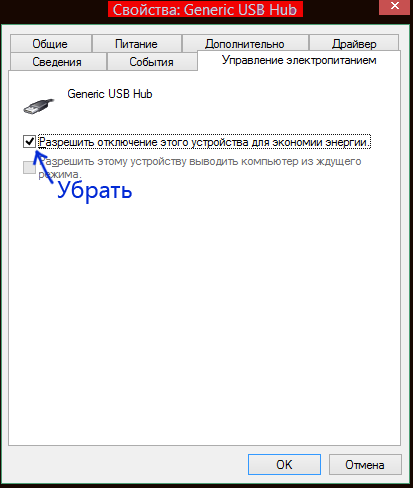
For each window, do the following:
Right click and select Properties
Open the Power Management tab
Uncheck "Allow the computer to turn off this device to save power"
Click OK.
After this action, there is a possibility that the computer will turn off correctly. But keep in mind that the time will decrease slightly battery life laptop.
The second significant probability is programs and services that prevent the PC from shutting down. when shutting down, the OS terminates all these processes, and if any of them freezes, then this creates a shutdown problem.
One of the revealing software glitches is a system stability monitor. You can get into it through the Control Panel, switch to the “Icons” view, the default is “Categories”, and click “Support Center.
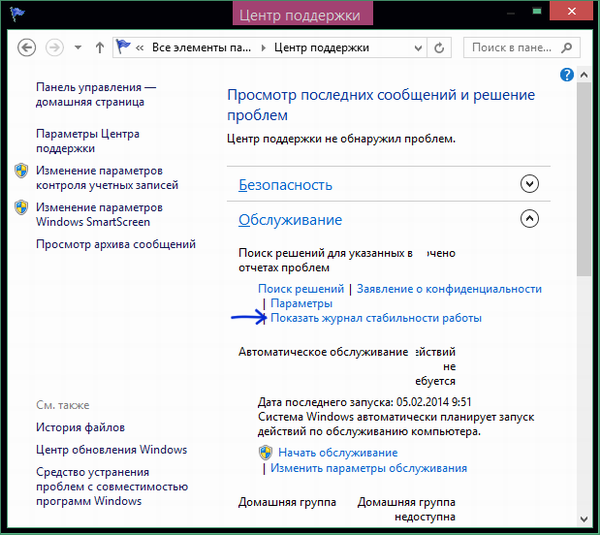
In the Support Center window, open the Maintenance section and launch System Stability Monitor by clicking the appropriate link.
The stability monitor clearly displays all processes and failures that occurred during the operation of the OS and finds out which programs caused them and, if necessary, disable or reinstall the application.







